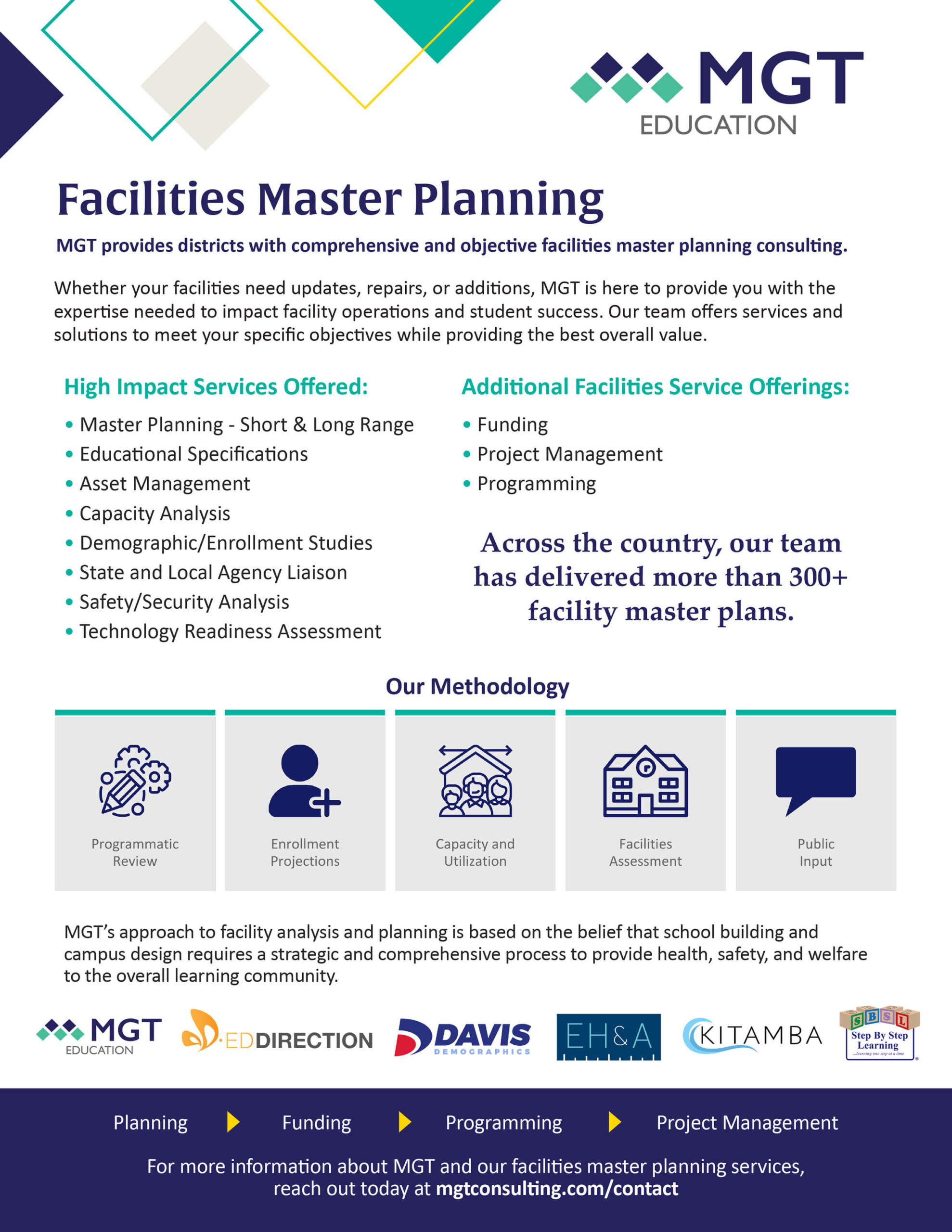As one of the largest geographical school districts in the country, spanning 17,000 square miles, Elko County School District (ECSD) in Nevada operates 23 school buildings. After a tax referendum related to school funding failed to pass in the November 2021 election, ECSD initiated a partnership with MGT in April 2022 to develop a facilities master plan.
The goal of the report was to address and prioritize the long-term facility needs of the school and make recommendations for more effective management of the district’s facilities in the future.
MGT used a multifaceted approach incorporating quantitative and qualitative data to complete this facility assessment. The quantitative aspects encompass facility assessments, enrollment projections, and demographic analysis. The qualitative insights were derived from discussions with District officials and community members. Together, the comprehensive methodology involved:
- Programmatic reviews
- Enrollment projections
- Capacity and utilization analysis
- Facilities assessments
- Public input
Suitability & Facility Assessment Findings
Our team interviewed school district leaders and staff to establish facility standards for evaluating educational suitability. The key areas of interest included the overall environment, circulation, program support facilities, space size, adjacencies, and utility appropriateness. Of ECSD’s 23 schools, six (or 26%) scored within poor or unsatisfactory levels on educational suitability.
In addition to educational suitability, each school building was also scored on building condition, grounds condition, and technology readiness. MGT’s Building Assessment System (BASYS) measures the amount of deferred maintenance in a school building’s major systems. Under this scoring system, two additional schools, for a total of eight, scored within poor or unsatisfactory levels. Common facility condition deficiencies included HVAC, water intrusion, and energy-inefficient lighting. Many schools lacked satisfactorily controlled access points, such as electronic access, buzzer systems, secure vestibules, and cameras.
Enrollment Findings
MGT’s analysis revealed that ECSD is expected to undergo significant demographic changes in the next ten years. While the overall population in the ECSD area is projected to grow by 8%, the school-age population (ages 5 to 19) is expected to remain relatively stable. Notably, the 10 to 14 age group is projected to decrease by 4%, while the 5 to 9 and 15 to 19 age groups are expected to grow by 2%. This demographic shift may pose challenges for ECSD, as it may not experience a substantial increase in student enrollment.
Capacity & Utilization Findings
With potentially stagnant enrollment numbers, we presented nationally recognized “best practices” which indicate capacity rates that are too high or too low are problematic. Too high means inadequate space for students and programs, while too low means inefficient use of space, which can be costly and often result in schools that are under-programmed and understaffed.
Already, our evaluation identified one ECSD school at an inadequate occupancy level, with four more schools very close to reaching this inadequate occupancy level. In contrast, 13 ECSD schools have occupancy rates that are classified as inefficient, with one school having a remarkably low occupancy rate of 13%. However, ECSD’s sprawling district size warrants these additional school locations to prevent excessive travel for students and staff.
Public Input Findings
One final essential element to our assessment involves collecting insights from diverse community members to ensure that a broad range of local perspectives shape the final plan. We facilitated seven in-person community meetings across the district and conducted a digital survey to ensure opportunities for all to participate. Most feedback received from these public forums supported the need for improving building conditions and providing more robust opportunities for all students. These insights allow our team to further shape and prioritize our final recommendations.
Solutions
ECSD faces a unique set of considerations when developing its facilities master plan due to its large geographical area. MGT’s recommendations focused heavily on the capacity & utilization findings, including classroom expansions at schools that were at or approaching inadequate levels of space. Alternatively, for those schools that scored inefficient in utilization, MGT recommended modifying student residence attendance areas to help balance enrollment.
Additional facility recommendations were also made to help develop a standard for critical minimum facility conditions, implement a maintenance routine for rural schools, and address various facility condition issues. MGT provided ECSD with a detailed planning guide to help prioritize projects and communicate their impact to the public. MGT also recommended that ECSD form a capital improvement advisory committee with representatives from each school community to inform and provide continued input on capital improvement plans. This advisory committee will allow ECSD to further improve community engagement and garner support for future projects and legislation.
The final facility master plan has equipped ECSD to navigate their future decisions with greater operational insights and with a clear communication plan to engage the larger community.
If your district could use similar support in navigating capacity and utilization issues or guiding community conversations surrounding facility improvements and budget constraints, contact our experts today to learn more about how we can help.











